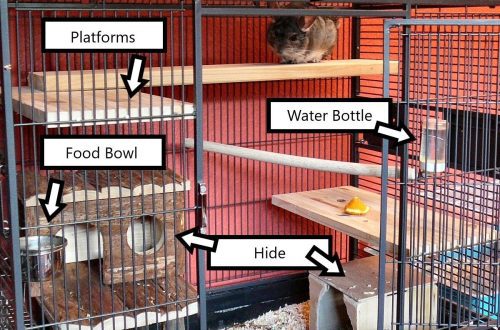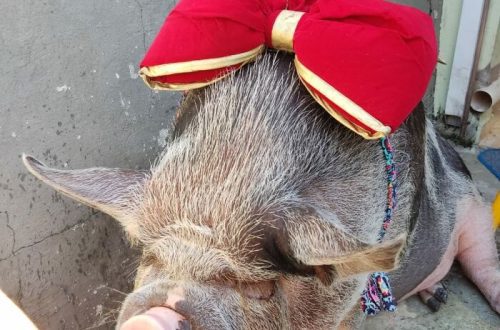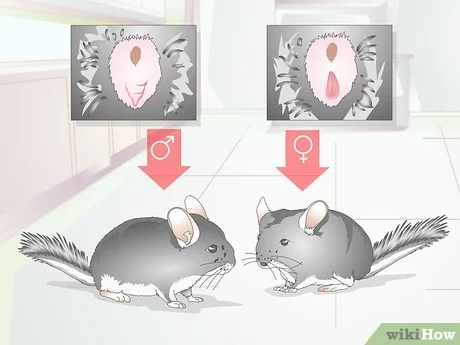
Mating and breeding chinchillas (breeding) at home for beginners
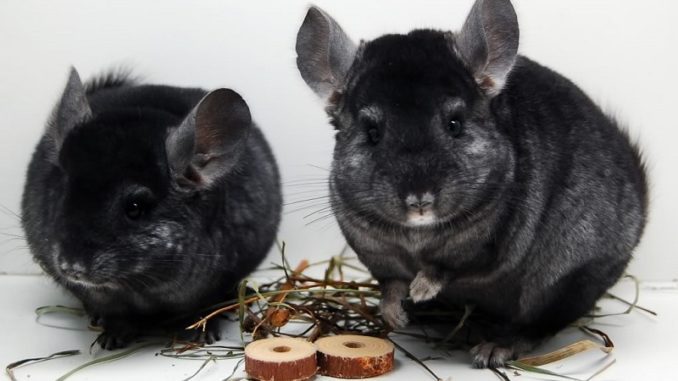
The chinchilla has recently become a very popular pet, often the owners of exotic rodents want to get offspring from a wonderful rodent. Breeding chinchillas at home for beginner chinchilla breeders is an interesting, but quite serious task that requires patience and increased care of the owner. If the rules for breeding animals are not followed, an attempt to mate can end in a fight and even death of pets. Therefore, before meeting animals, it is necessary to study the physiological characteristics and subtleties of the behavior of furry animals.
Contents
When do chinchillas mate?
Under natural habitat conditions, the mating season for exotic rodents begins in the spring and can last until autumn, so chinchilla breeders also try to breed chinchillas from March to November.
Reproduction of chinchillas at home should be carried out with enhanced balanced feeding and a microclimate that is comfortable for the animals, an increase in the air temperature in the room above +20 degrees and dry air, malnutrition or rodent diseases have an extremely negative effect on the cultivation of chinchillas.
Puberty in chinchillas
Puberty of chinchillas occurs at 6-8 months for females and at 7-9 months for males.
Sexual maturity in females can occur at 3-4 months, and males can cover the female by the age of 5 months. Early mating of a chinchilla causes a weakening of the body of the female, the pathology of pregnancy and childbirth. Therefore, healthy animals with a body weight of at least 500 g are selected for mating at the age of 7-9 months for females and from 6 months for males. Although chinchillas are ready to breed at 6-8 months of age, veterinarians do not recommend covering females until they are one year old. Pregnancy up to 12 months causes a halt in the growth of the skeleton and muscle mass of the female, this negatively affects the general condition of the fluffy animal and its offspring.
Without harm to their own health, females can bring 2 broods annually. A week before giving birth, it is recommended to transplant the male for six months so that the chinchilla can recover from a long pregnancy and feeding babies. The male is able to fertilize the female a day after giving birth, which can result in the death of newborns and pathological pregnancy of the female.
Mating chinchillas in the wild
For successful breeding of chinchillas at home, beginners need to know how chinchillas breed in nature. Chinchillas live in numerous flocks in which matriarchy reigns. It is females who behave aggressively towards males, hissing, biting and shooting urine. Unusual rodents zealously guard their territory; the appearance of any stranger on their possessions is perceived by fluffy animals quite belligerently. Therefore, mating chinchillas at home sometimes ends in fights or the death of pets.
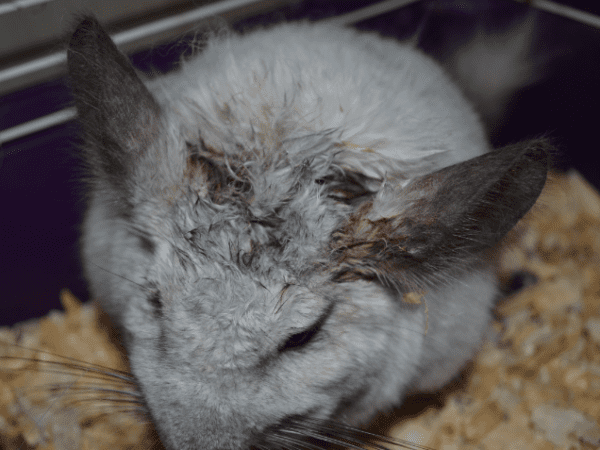
Sometimes chinchillas do not breed, because the animals do not develop relationships, when the partner is replaced and the processes of acquaintance and planting are observed, cute fluffy cubs are born in the animals.
If a couple is picked up, then chinchillas breed 2-3 times a year, live a peaceful family all their lives, kiss, play and sleep together. In natural habitat, a flock of unusual rodents consists of married couples, males and females help each other to gently grow chinchillas and actively protect their homes from strangers. In nature, a male chinchilla can live with one female and simultaneously fertilize other females. This feature of American rodents is used in polygamous breeding, when one male fertilizes 4 females.
Mating relatives of chinchillas is highly discouraged in order to avoid getting a weak litter, aggravated by congenital developmental anomalies.
How to select and prepare chinchillas for mating
Breeding and keeping chinchillas is based on the competent selection of a pair, the correct observance of the processes of acquaintance and planting, the creation of optimal conditions for a pregnant and lactating female, as well as newborn offspring.
To obtain healthy viable chinchillas, healthy, active, well-fed individuals obtained from dairy females are allowed, with a body weight of at least 500 g, a calm, friendly character, with thick and uniform fur, and the absence of acute and chronic diseases.
Breeding chinchillas with hereditary diseases, addictions, quarrelsome nature and anatomical abnormalities is highly discouraged.
Partner Acquisition
Breeding at home begins with the purchase of a partner and a monthly quarantine of a new tenant. An animal can be contagious or get sick due to stress after a change of scenery, so quarantine measures are essential.
After a month of quarantine, the acquaintance stage begins, in order to successfully bring the female and male together, it is necessary to carefully monitor the behavior of animals in this period. Depending on the establishment of relations, chinchillas can get acquainted from a week to a month. The owners of fluffy animals are highly discouraged from rushing and starting to sit down until the unusual rodents get used to each other. At this stage, it is necessary to accustom an exotic rodent to someone else’s smell of a partner. Otherwise, at the first meeting there will be a bloody battle for their rightful territory.
Acquaintance of partners
For acquaintance, you can place two small cages with chinchillas next to each other so that they can see and smell someone else’s without harming each other. The disadvantage of this method may be the wetting of the male’s hair from the shots with the urine of the female. The cages must be placed at such a distance that the animals can see and smell, but not have the opportunity to bite off the fingers, mustache or nose of the partner through the gaps between the bars.
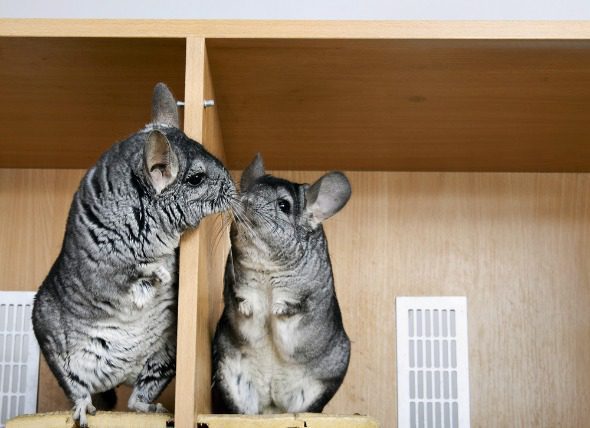
A good effect is the bathing of the male in the sand of the female, to which the powdered feces of the female are added and vice versa. You can take turns bathing the animals in the same sand bath immediately before placing a row of cages with emotional animals.
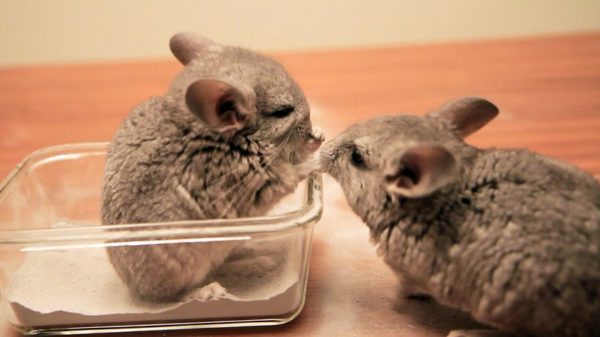
Sometimes chinchillas change cages, when they are in a foreign territory, rodents get used to the smell of a neighbor without causing damage to each other. An aggressive hungry partner can be placed right in a carrier cage in an aviary with a calm individual, someone else’s smell, hunger and a closed space make the fighter calm down and get used to the smell of a neighbor.
Joint walks
When fluffy rodents begin to react calmly to each other, it is recommended to arrange a joint walk for a couple in an unfamiliar territory for animals under the careful supervision of the owner. In order to breed chinchillas at home, it is necessary to study and apply all methods of acquaintance, carefully controlling the situation.
Most often, chinchillas have tender true love for life, if the acquaintance stage is maintained correctly, you can proceed to planting animals. Successfully breed chinchillas with a calm temperament over the age of a year, provided that the female is slightly older than the male.
Video: breeding chinchillas at home
Planting chinchillas
The owner should always be nearby at the initial stage of planting. Friendly and gentle to each other, rodents, when placed in one cage, can arrange a serious fight. In such battles, the male most often suffers, the female beats and bites the scruff and lower back of the male, the consequences of aggression turn into large purulent wounds.
How to plant chinchillas
When planting the owner of exotic rodents, it is recommended to follow some rules:
- immediately before planting, it is necessary to thoroughly wash the cage where chinchillas will be mated, the cage must be at least 1 m in height and 0 m in width;
- the cage should be freed from shelves, ladders and accessories as much as possible in order to avoid injury during a possible fight, it is advisable to install a labyrinth – a box with several exits through which the male can escape with the aggressive behavior of the female;
- before planting, the female must be bathed for a long time in the sand with male feces, the male is placed in an uncleaned female enclosure to soak in the smell of the female’s urine;
- it is desirable to launch the male first into your cage, at the end they send the female;
- within 3-4 hours from the moment of planting, the owner must always be nearby. In the event of a fierce battle, it is necessary to immediately seat the animals and provide urgent veterinary care to the victim;
- it is recommended to put a sufficient amount of coarse hay on the floor of the cage. Both chinchillas will be interested in eating and sorting out grass, which will distract partners from a showdown;
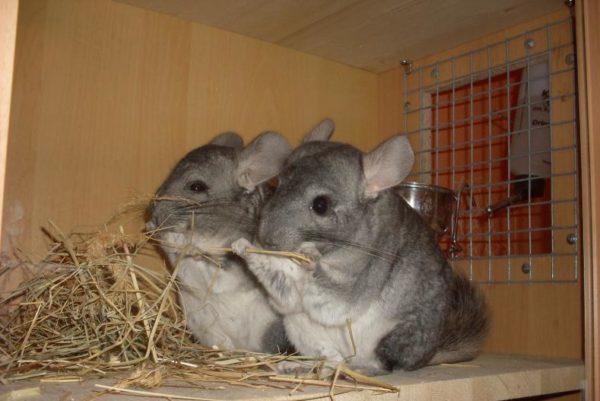
- until the end of the day, it is necessary to control relations in the enclosure, an imaginary truce can instantly turn into a bloody fight. Males try to care for the female even in the absence of estrus, which can provoke even a calm female to a violent display of aggression;
- it is advisable to install a large bathing bath in the aviary, joint sand procedures soothe and bring partners very close;
- even in a long-term pair, fights may arise at any time, which should not be left without the attention of the owner;
- a successfully placed couple begins to bathe, eat and sleep together, kiss and play, causing tenderness of the owners;
- a transplanted pair is intensively fed with high-quality concentrated feed with the addition of vitamin supplements, fresh fruits and berries, dried hay and herbs;
- the owner needs to be patient, sometimes planting lasts for months, even with peaceful coexistence, chinchillas do not want to have offspring;
- in rare cases, it is not possible to transplant the selected individuals, then it is necessary to replace one partner with another individual in compliance with all the terms and rules of quarantine, acquaintance and introduction.
Chinchilla folder
You can mate exotic rodents only during estrus in a female chinchilla, which is repeated every 30 to 45 days. The frequency of this phase of the sexual process depends on the individual characteristics of the female, the minimum cycles consist of 20 days, with the maximum cycle, estrus is repeated after 60 days. The sexual cycle of a female chinchilla consists of three stages, which can be determined by the behavior of partners towards each other.
The stage of excitation of the sexual cycle
Duration 1-3 days, consists of sexual arousal, estrus, estrus and ovulation. The female’s loop opens, the male is actively interested in the female, the female accepts courtship, and the animals mate. Ovulation occurs 12-24 hours after estrus, the outcome of this stage will be conception with successful mating or the inhibition stage.
Deceleration stage
The female’s loop closes, the female shows indifference to the male, in this period it is necessary to diagnose the female’s pregnancy by weighing and detecting vaginal plugs in the form of white paraffin flagella 2-3 cm in size. In the absence of conception, the balancing stage begins.
Balancing stage
Lasts until the next stage of excitation of the sexual cycle, the female’s loop is closed, both partners are in a balanced relationship with each other.
Chinchillas are in heat at the age of 4-8 months. With early maturation, the first estrus can be observed in a 3-month-old female, with late maturation – after 12 months. It is highly not recommended to plant furry animals at the first estrus in a female. The body of the female needs to get stronger and prepare for the reproduction of offspring, so it is better to wait out the first estrus.
Chinchillas are in heat for 2-3 days. During this period, ovulation occurs in the body of the female, accompanied by the production of thick mucus to improve the advancement of spermatozoa and the final attachment of fertilized eggs to the uterine wall. The loop of the female opens only during estrus and childbirth, it is during these periods that the female can be covered by the male. The rest of the time, the female’s genitals are closed to prevent external infections. The owner of a chinchilla needs to be able to determine the onset of the next estrus in a female in order to successfully plan the introduction of furry animals.
Signs of estrus in a female
Male behavior
The characteristic behavior of the male can suggest that the female is in heat: the animal is actively interested in and cares for the female, makes loud mating sounds, twitches its fluffy tail, bites the female’s fur and often makes attempts to jump on the female for mating.
Inspection of the loop of the female
The genital organs of the female swell and open, acquire a pink color, white discharge from the loop is observed, the female’s nipples become long and red.
How chinchillas mate
Courtships to males can be observed during the day and at night, and mating acts occur most often at night. Evidence of mating that has occurred will be tufts of wool on the floor of the cage and the dried seminal fluid of the male in the form of a white tourniquet. The sexual intercourse lasts for several seconds, the male jumps on the female, bites the fur on his back with his teeth and the process of intercourse takes place. When conception occurs, a vaginal plug is formed in the body of the female, which protects the body of the pregnant female from the penetration of infection from the outside and prevents repeated mating.
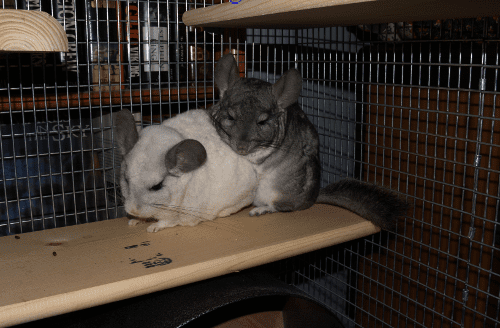
The result of successful mating of wonderful rodents is the onset of a long-awaited pregnancy, which lasts 105-115 days and ends with the birth of newborn offspring.
Video: how chinchillas mate at home
Proper breeding of chinchillas at home is a very interesting and delicate process. The existing pair of rodents shows almost “swan love” to each other, and the sight of charming fluffy and big-eyed puppies causes awe and tenderness in every member of the family.
Breeding chinchillas at home: how rodents mate and breed
3 (59.18%) 147 votes




